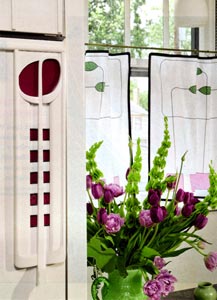West Virginia homeowner Carrie Russell is under the spell of early-20th-century Scots designer Charles Rennie Mackintosh. She created a stunning new kitchen in his style.

The unique refrigerator handle is modeled after the pull on a wardrobe Mackintosh had designed for Mrs. Blackie near Glasgow in 1902. Curtains have a stylized motif of pink and green squares intersected by linear black stems ending in flower heads, suggesting a summer rose garden.
The American Foursquare house in Morgantown, West Virginia, deserved a better kitchen than the unappealing cubbyhole with avocado walls and greasy nicotine stains. Carrie Russell had saved this room for last: it was a big job that would cause upheaval. In her deliberate restoration of the 1921 house. Carrie had been inspired by the great Arts and Crafts-era designers, including William Morris. Gustav Stickley. Charles Limbert, and C.F.A. Voysey. She knew nothing about Charles Rennie Mackintosh, though, until she came across a bolt of fabric designed by him, on eBay. She studied his architecture and decorative arts, and it became clear to her that the kitchen should be devoted to the Scotsman's designs. She moved the refrigerator to the basement and began the makeover.
First came three false starts with contractors who didn't understand her vision. Then Carrie discovered Pat Herforth, a talented local artisan. She intro, duced him to Mackintosh, sharing books and photographs, even sending him to a visiting scholars workshop. As a trial run, Pat first fabricated a version of a Mackintosh-designed bed; Carrie knew she'd found her cabinetmaker. Carrie and Pat took Hill House, Mackintosh's avant-garde 1902 villa for publisher Walter Blackie outside of Glasgow. as a starting point. Mackintosh believed that nature and science should be honored equally. and his still-striking designs for Hill House reflected his philosophy: stylized tulips and roses (nature) along with checkered squares (science) were stenciled on walls and fabrics, carved into furniture and cabinets, and repeated in stained-glass chandeliers.

Inspired by the bookcase-lined window bench the parlor at Hill House, this seating arrangementis outlined by slender, floor-to-ceiling columns punctuated with stained-glass checks in pink.


Mackintosh had designed a commanding wardrobe for Mrs. Blackie. It was adorned with a striking pull of abstract stained-glass tulips and squares. This piece became the central motif for Carrie's kitchen (note the refrigerator handle). Sinuous motifs inspired the decoration of the surrounding cabinets, translated into a symphony of curvilinear flowers. stained-glass spheres, and geometric grids. Handles and pulls were incorporated into the tendrils of stylized tulips carved across each drawer and cabinet front, but Pat was careful to limit the decoration of each cabinet to one arresting but integrated element. leaving enough space between them so that the entire room did not become a cacophony of overwhelming patterns. The space between is as important as the decorative elements themselves.
A reused base cabinet became the kitchen island and the centerpiece of the room. Microwave oven. warming drawer, trash compactor. and LCD TV for the children are camouflaged with fronts that retract into the cabinet when appliances are in use. A bi-fold retractable door covers a phone cabinet on the wall. Cabinets continue into the adjoining butler's pantry, where a tall cupboard stands at attention, a vertical row of stained-glass squares outlining each door with scientific precision.
Judy Soccio, a custom drapery designer, re-created the Mackintosh-designed curtains. (Her husband is Juan Rodriguez, the stained-glass artist whose work is also in this kitchen.) Patterns were digitally sized and printed onto the fabric—a much less labor-intensive alternative to hand stenciling or embroidery.
Mackintosh meant for his Hill House parlor, bathed in light, to be a dramatic contrast to the dark and somber entry hall. The parlor is highlighted with silver and summery pink accents. Carrie picked up this light palette in her kitchen, painting the cabinets and ceiling Benjamin Moore's fresh 'Dove White' and the walls silvery 'Full Moon'. Pat Herforth built a curved kitchen table and set of chairs to nestle in the back corner. No detail escaped Pat's eye: electrical switchplates and outlet covers, the doorbell chime cover. and kick vents in the island wear hand-carved motifs. Overhead rectilinear stained-glass chandeliers were made from zinc and purple leaded-glass panels.
There's nothing better than when homeowners, contractors, and artisans work together to create some- thing extraordinary. Carrie and company certainly had synergy. and a shared passion for the project.

Above: Cabinets continue into the adjoining butler's pantry. Below: The stove hood is surmounted with cabinet doors, inset with stylized ruby-pink stained-glass flowers and white fused-glass roundels. Details: the floor-to-ceiling posts in the seating area, and the tall pantry cabinet.




Designer Judy Soccio, homeowner Carrie Russell, and cabinetmaker Pat Herforth in the window nook. The chairs have Mackintosh-inspired cutouts and mother of pearl inlays. Original oak floors were conserved and refinished.
Meticulous recreations of Mackintosh's original panels for the Hill House parlor, Carrie's kitchen curtains were designed for Judy Soccio's "design on demand- or "engineered fabric" process, an economical solution. Photographs were made of the desired pattern, uploaded as digital files, and then manipulated with computer graphics to the exact proportions and size needed for the room. Designs were printed with a Dupont Artistri ink-jet printer, which makes available virtually any color. (The pink in the curtains match the room's stained-glass inserts.) A big advantage of the process is that the engineered fabric allows exact placement of a design—especially helpful for round table covers, slipcovers, and bedskirts. A wide range of fabrics can be used, from natural linens to cotton twills, sheeting, canvas, silk and cotton jerseys. Minimum orders can be as short as one yard.